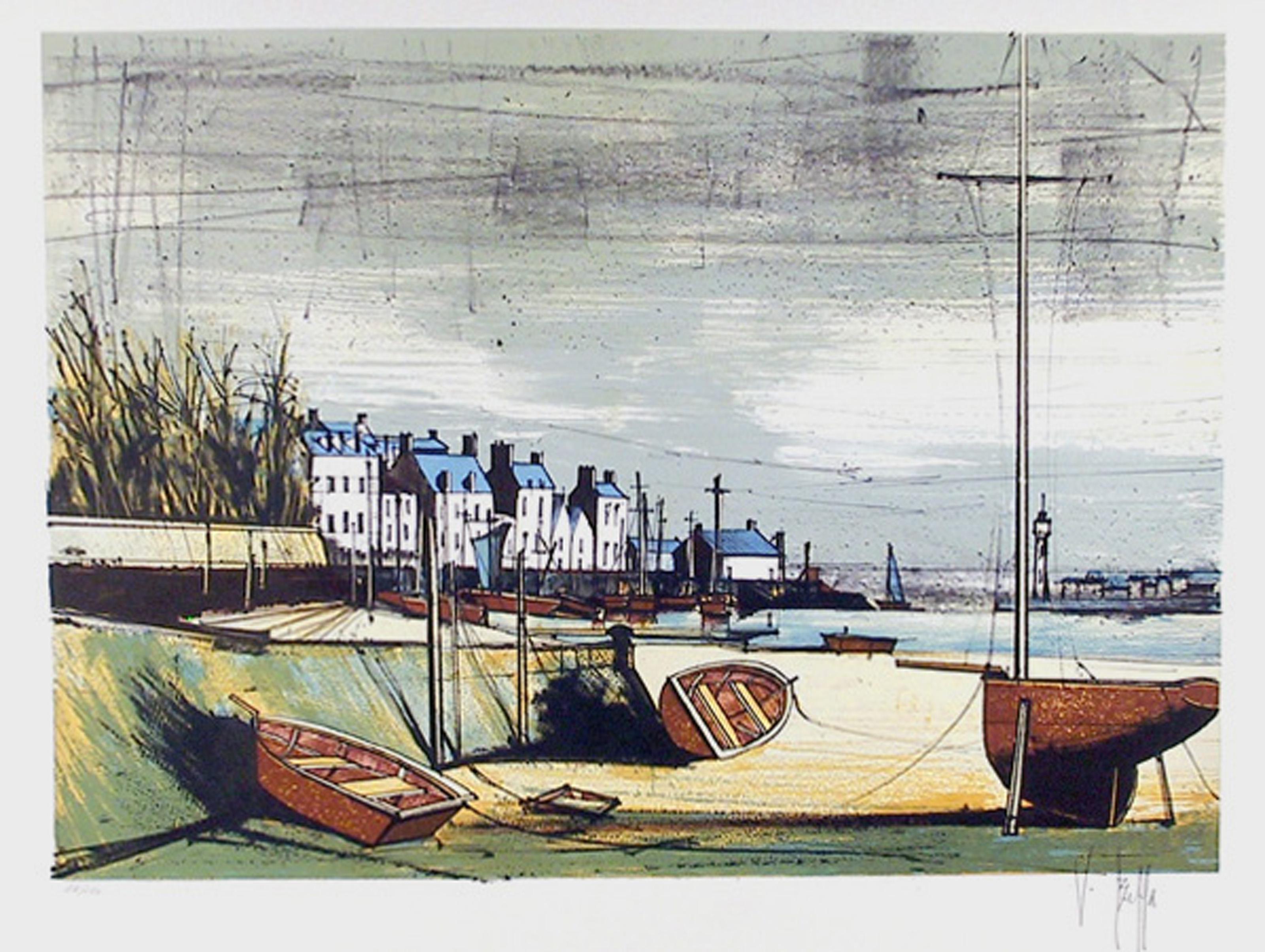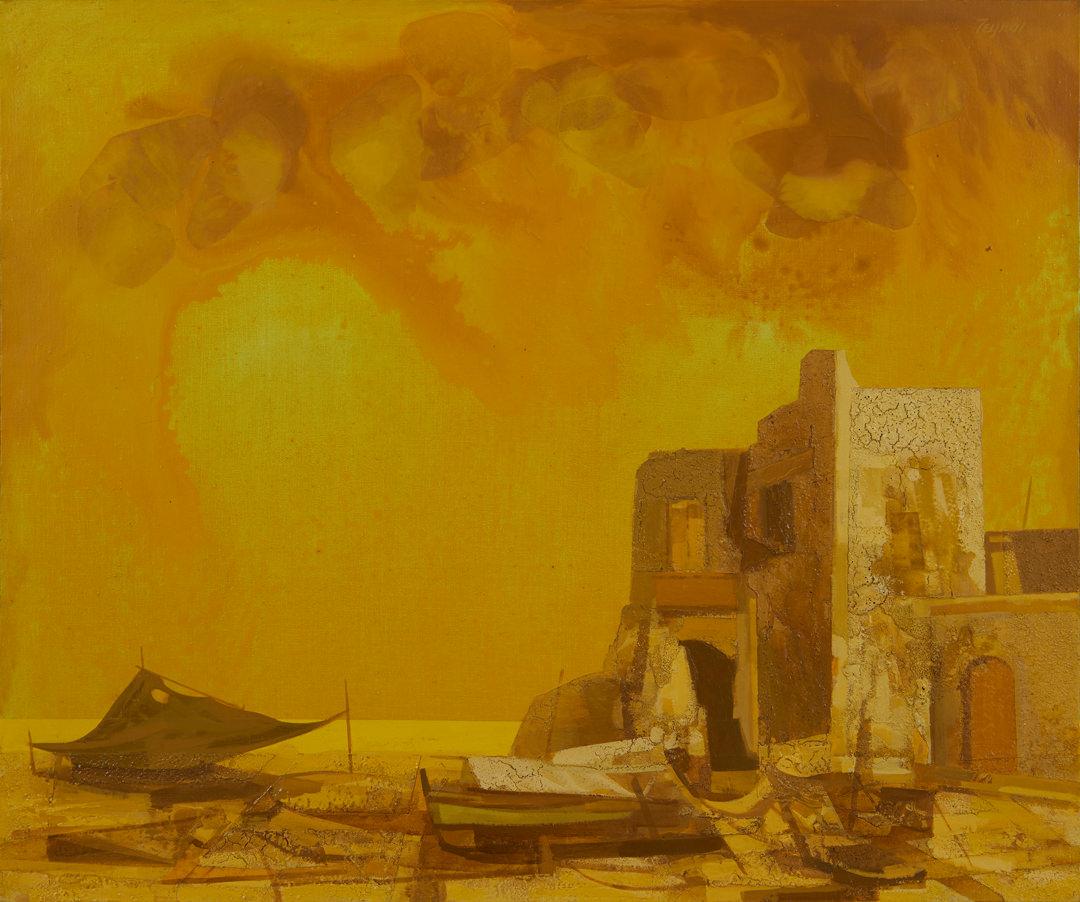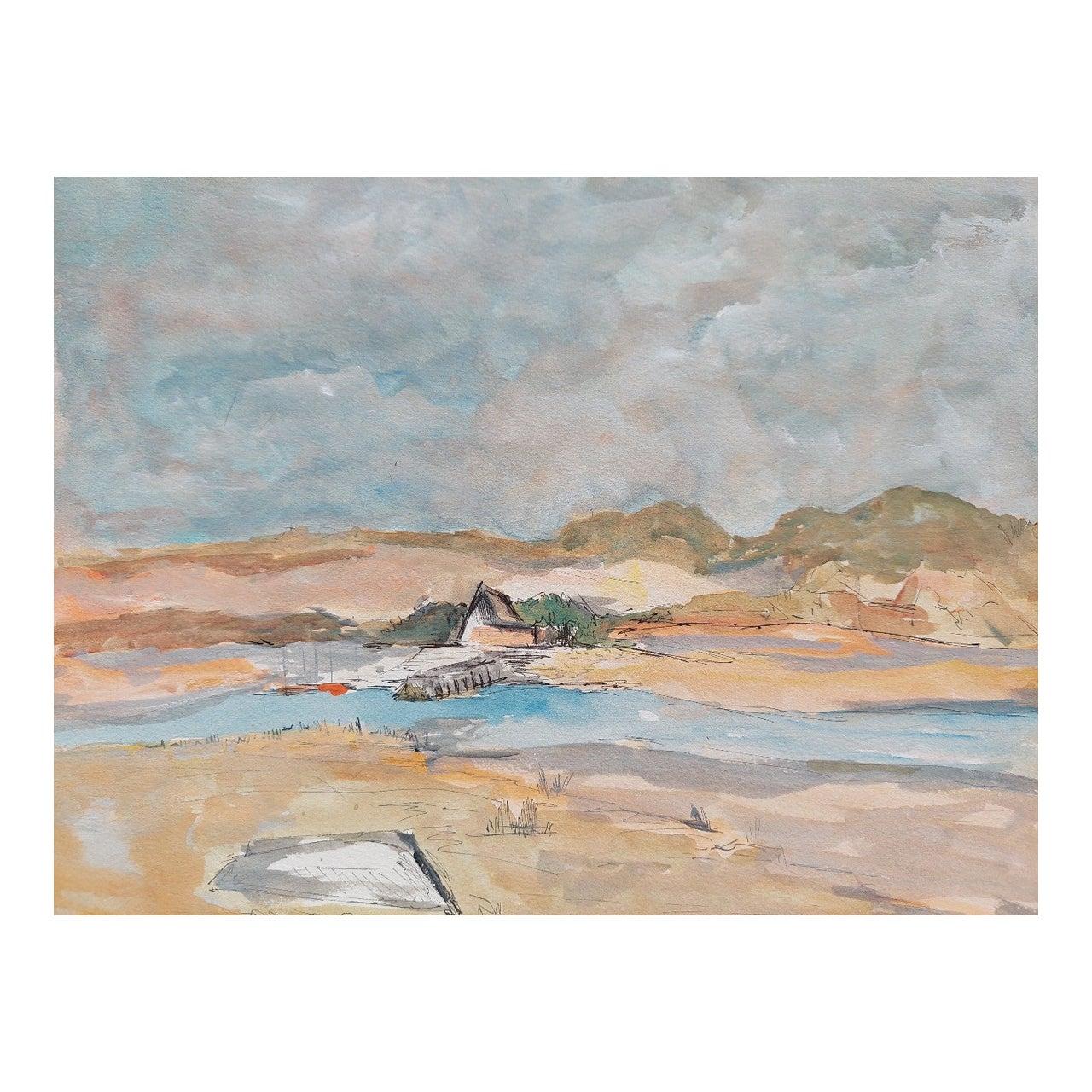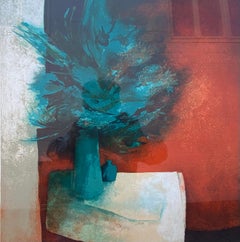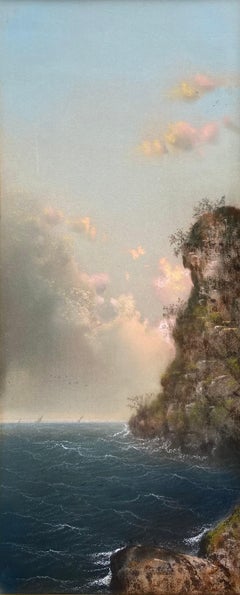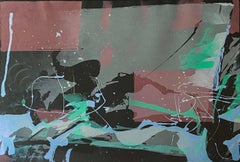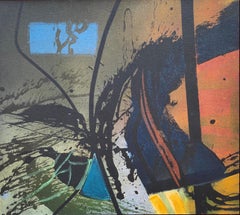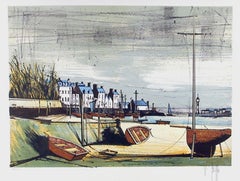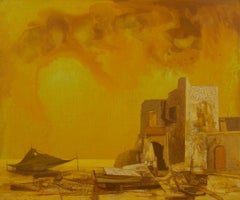Items Similar to “Seaside Landscape”
Want more images or videos?
Request additional images or videos from the seller
1 of 11
Claude Gaveau“Seaside Landscape”Circa 1980
Circa 1980
$460
$57520% Off
£348.54
£435.6720% Off
€399.92
€499.9020% Off
CA$647.29
CA$809.1220% Off
A$711.55
A$889.4420% Off
CHF 373.96
CHF 467.4520% Off
MX$8,640.86
MX$10,801.0820% Off
NOK 4,665.06
NOK 5,831.3320% Off
SEK 4,419.82
SEK 5,524.7720% Off
DKK 2,984.70
DKK 3,730.8720% Off
About the Item
Original colored lithograph of a seaside village done in a post modernist style. Edition 46/175 in pencil lower left margin. Signed in pencil by the artist lower right margin. Circa 1980. Condition is excellent. Professionally rematted. Under glass. Framed in its original thin white metal frame. Overall framed measurements are 25 by 31.5 inches. Provenance: A Southampton, New York estate.
Claude Gaveau was born in Neuilly-sur-Seine, France on December 5, 1940.
Claude Gaveau is an internationally acclaimed master celebrated for his nudes and still life compositions. His works are harmonious with a brilliant palette of vibrant colors that seem to be overlaid with silk giving a soft and subtle result. Gaveau’s art has been described by many critics and fellow artists as “Symphonic” orchestrating the elements to create perfectly balanced compositions that are withdrawn from reality yet not quite abstract, offering a sense of mystery rather than a clear definition.
His works capture the beauty and innocence of flowers and the female form he paints with his brush. Gaveau has created a style all of his own that is immediately identifiable and enjoyable.
- Creator:Claude Gaveau (1940, French)
- Creation Year:Circa 1980
- Dimensions:Height: 20.75 in (52.71 cm)Width: 19.5 in (49.53 cm)Depth: 1 in (2.54 cm)
- Medium:
- Movement & Style:
- Period:
- Condition:
- Gallery Location:Southampton, NY
- Reference Number:1stDibs: LU14114945622
About the Seller
5.0
Platinum Seller
Premium sellers with a 4.7+ rating and 24-hour response times
Established in 1977
1stDibs seller since 2013
547 sales on 1stDibs
Typical response time: 1 hour
- ShippingRetrieving quote...Shipping from: Southampton, NY
- Return Policy
Authenticity Guarantee
In the unlikely event there’s an issue with an item’s authenticity, contact us within 1 year for a full refund. DetailsMoney-Back Guarantee
If your item is not as described, is damaged in transit, or does not arrive, contact us within 7 days for a full refund. Details24-Hour Cancellation
You have a 24-hour grace period in which to reconsider your purchase, with no questions asked.Vetted Professional Sellers
Our world-class sellers must adhere to strict standards for service and quality, maintaining the integrity of our listings.Price-Match Guarantee
If you find that a seller listed the same item for a lower price elsewhere, we’ll match it.Trusted Global Delivery
Our best-in-class carrier network provides specialized shipping options worldwide, including custom delivery.More From This Seller
View All“Teal Bouquet”
By Claude Gaveau
Located in Southampton, NY
Original colored lithograph of a bouquet in teal by the well known French artist, Claude Gaveau. Edition 5/175 in pencil lower left margin. Signed in pencil by the artist lower right...
Category
1980s Post-Modern Still-life Prints
Materials
Archival Paper, Lithograph
$460 Sale Price
20% Off
“Seaside Cliffs, California”
Located in Southampton, NY
Beautiful original pastel on archival card stock from Paris of the craggy seaside cliffs of California by the well known Hudson River artist, George Douglas Bremerton. Signed lower left. Circa 1880. Condition is excellent. Under glass. The artwork is housed in its original ornate scroll designed frame. Overall framed measurements are 33 by 19 inches. Provenance: A East Coast Florida estate.
George Douglas Brewerton received lessons in art from Prof. Robert W. Weir at West Point where his father was Superintendent. In 1874, he was detailed to San Francisco as an officer in the Stevenson Regiment. In 1848, he underwent many adventures in Western deserts and mountains with Kit Carson, who crossed the country with news of the California Gold Rush. After serving as an aide to Gen. Rufus Saxton during the Civil War, Brewerton called himself “Colonel,” although he never received an army commission...
Category
1870s Hudson River School Landscape Drawings and Watercolors
Materials
Pastel, Archival Paper
$2,240 Sale Price
20% Off
“Shore Sentry”
By Syd Solomon
Located in Southampton, NY
Shore Sentry, is an original color, limited edition lithograph on handmade German black etching paper; printed by Topaz Editions in 1977. Artist proofs 10. Edition size 100. Provenance:: A Sarasota, Florida collector
Signed: Artist signed lower left with edition size
Image size: 22 by 30 inches
Sheet size: 30 by 38 inches
Edition 38/100
Condition: Excellent
Overall framed size: 30.25 by 38.25 inches
Framed under plexiglass in chrome colored metal gallery frame
SYD SOLOMON BIOGRAPHY
Written by Dr. Lisa Peters/Berry Campbell Gallery
“Here, in simple English, is what Syd Solomon does: He meditates. He connects his hand and paintbrush to the deeper, quieter, more mysterious parts of his mind- and he paints pictures of what he sees and feels down there.”
--Kurt Vonnegut Jr. from Palm Sunday, 1981
Syd Solomon was born near Uniontown, Pennsylvania, in 1917. He began painting in high school in Wilkes-Barre, where he was also a star football player. After high school, he worked in advertising and took classes at the Art Institute of Chicago. Before the attack on Pearl Harbor, he joined the war effort and was assigned to the First Camouflage Battalion, the 924th Engineer Aviation Regiment of the US Army. He used his artistic skills to create camouflage instruction manuals utilized throughout the Army. He married Ann Francine Cohen in late 1941. Soon thereafter, in early 1942, the couple moved to Fort Ord in California where he was sent to camouflage the coast to protect it from possible aerial bombings. Sent overseas in 1943, Solomon did aerial reconnaissance over Holland. Solomon was sent to Normandy early in the invasion where his camouflage designs provided protective concealment for the transport of supplies for men who had broken through the enemy line. Solomon was considered one of the best camoufleurs in the Army, receiving among other commendations, five bronze stars. Solomon often remarked that his camouflage experience during World War II influenced his ideas about abstract art. At the end of the War, he attended the École des Beaux-Arts in Paris.
Because Solomon suffered frostbite during the Battle of the Bulge, he could not live in cold climates, so he and Annie chose to settle in Sarasota, Florida, after the War. Sarasota was home to the John and Mable Ringling Museum of Art, and soon Solomon became friends with Arthur Everett “Chick” Austin, Jr., the museum’s first Director. In the late 1940s, Solomon experimented with new synthetic media, the precursors to acrylic paints provided to him by chemist Guy Pascal, who was developing them. Victor D’Amico, the first Director of Education for the Museum of Modern Art, recognized Solomon as the first artist to use acrylic paint. His early experimentation with this medium as well as other media put him at the forefront of technical innovations in his generation. He was also one of the first artists to use aerosol sprays and combined them with resists, an innovation influenced by his camouflage experience.
Solomon’s work began to be acknowledged nationally in 1952. He was included in American Watercolors, Drawings and Prints at the Metropolitan Museum of Art, New York. From 1952–1962, Solomon’s work was discovered by the cognoscenti of the art world, including the Museum of Modern Art Curators, Dorothy C. Miller and Peter Selz, and the Whitney Museum of American Art’s Director, John I. H. Baur. He had his first solo show in New York at the Associated American Artists Gallery in 1955 with “Chick” Austin, Jr. writing the essay for the exhibition. In the summer of 1955, the Solomons visited East Hampton, New York, for the first time at the invitation of fellow artist David Budd. There, Solomon met and befriended many of the artists of the New York School, including Jackson Pollock, Franz Kline, Willem de Kooning, James Brooks, Alfonso Ossorio, and Conrad Marca-Relli. By 1959, and for the next thirty-five years, the Solomons split the year between Sarasota (in the winter and spring) and the Hamptons (in the summer and fall).
In 1959, Solomon began showing regularly in New York City at the Saidenberg Gallery with collector Joseph Hirshhorn buying three paintings from Solomon’s first show. At the same time, his works entered the collections of the Whitney Museum of American Art, the Solomon R. Guggenheim Museum, and the Wadsworth Athenaeum in Hartford, Connecticut, among others. Solomon also began showing at Signa Gallery in East Hampton and at the James David Gallery in Miami run by the renowned art dealer, Dorothy Blau.
In 1961, the Guggenheim Museum’s H. H. Arnason bestowed to him the Silvermine Award at the 13th New England Annual. Additionally, Thomas Hess of ARTnews magazine chose Solomon as one of the ten outstanding painters of the year. At the suggestion of Alfred H. Barr, Jr., the Museum of Modern Art’s Director, the John and Mable Ringling Museum in Sarasota began its contemporary collection by purchasing Solomon’s painting, Silent World, 1961.
Solomon became influential in the Hamptons and in Florida during the 1960s. In late 1964, he created the Institute of Fine Art at the New College in Sarasota. He is credited with bringing many nationally known artists to Florida to teach, including Larry Rivers, Philip Guston, James Brooks, and Conrad Marca-Relli. Later Jimmy Ernst, John Chamberlain, James Rosenquist, and Robert Rauschenberg settled near Solomon in Florida. In East Hampton, the Solomon home was the epicenter of artists and writers who spent time in the Hamptons, including Alfred Leslie, Jim Dine, Ibram Lassaw, Saul Bellow...
Category
1970s Post-Modern Abstract Prints
Materials
Handmade Paper, Lithograph
“Gulfside”
By Syd Solomon
Located in Southampton, NY
Original, oil paint and acrylic paint on canvas by the well known American artist, Syd Solomon. Signed bottom middle by the artist. Titled and dated verso 1983. Condition is excellent. Original gallery floating frame. Overall framed measurements are 38 by 42 inches. Provenance: A Sarasota, Florida collector.
SYD SOLOMON BIOGRAPHY
Written by Dr. Lisa Peters/Berry Campbell Gallery
“Here, in simple English, is what Syd Solomon does: He meditates. He connects his hand and paintbrush to the deeper, quieter, more mysterious parts of his mind- and he paints pictures of what he sees and feels down there.”
--Kurt Vonnegut Jr. from Palm Sunday, 1981
Syd Solomon was born near Uniontown, Pennsylvania, in 1917. He began painting in high school in Wilkes-Barre, where he was also a star football player. After high school, he worked in advertising and took classes at the Art Institute of Chicago. Before the attack on Pearl Harbor, he joined the war effort and was assigned to the First Camouflage Battalion, the 924th Engineer Aviation Regiment of the US Army. He used his artistic skills to create camouflage instruction manuals utilized throughout the Army. He married Ann Francine Cohen in late 1941. Soon thereafter, in early 1942, the couple moved to Fort Ord in California where he was sent to camouflage the coast to protect it from possible aerial bombings. Sent overseas in 1943, Solomon did aerial reconnaissance over Holland. Solomon was sent to Normandy early in the invasion where his camouflage designs provided protective concealment for the transport of supplies for men who had broken through the enemy line. Solomon was considered one of the best camoufleurs in the Army, receiving among other commendations, five bronze stars. Solomon often remarked that his camouflage experience during World War II influenced his ideas about abstract art. At the end of the War, he attended the École des Beaux-Arts in Paris.
Because Solomon suffered frostbite during the Battle of the Bulge, he could not live in cold climates, so he and Annie chose to settle in Sarasota, Florida, after the War. Sarasota was home to the John and Mable Ringling Museum of Art, and soon Solomon became friends with Arthur Everett “Chick” Austin, Jr., the museum’s first Director. In the late 1940s, Solomon experimented with new synthetic media, the precursors to acrylic paints provided to him by chemist Guy Pascal, who was developing them. Victor D’Amico, the first Director of Education for the Museum of Modern Art, recognized Solomon as the first artist to use acrylic paint. His early experimentation with this medium as well as other media put him at the forefront of technical innovations in his generation. He was also one of the first artists to use aerosol sprays and combined them with resists, an innovation influenced by his camouflage experience.
Solomon’s work began to be acknowledged nationally in 1952. He was included in American Watercolors, Drawings and Prints at the Metropolitan Museum of Art, New York. From 1952–1962, Solomon’s work was discovered by the cognoscenti of the art world, including the Museum of Modern Art Curators, Dorothy C. Miller and Peter Selz, and the Whitney Museum of American Art’s Director, John I. H. Baur. He had his first solo show in New York at the Associated American Artists Gallery in 1955 with “Chick” Austin, Jr. writing the essay for the exhibition. In the summer of 1955, the Solomons visited East Hampton, New York, for the first time at the invitation of fellow artist David Budd...
Category
1980s Abstract Expressionist Abstract Paintings
Materials
Canvas, Oil, Acrylic
$36,000
“Spanish Beach Scene”
By Benjamin Stahl
Located in Southampton, NY
Here for your consideration is a very interesting figurative painting by the well know American artist, Ben Stahl. Dedicated to Helen lower left and signed and dated lower left by the artist, 1978. Titled verso. Condition is excellent.
The painting is mounted over a matted period thin decorated gold frame. Overall framed measurements are 17 by 13.5 inches. Frame and mat in fine condition. Provenance: Saint Petersburg, Florida estate.
Benjamin Albert Stahl (September 7, 1910 – October 19, 1987) was an American artist, illustrator and author. He showed precocious talent, winning a scholarship to the Art Institute of Chicago at age twelve. His artwork appeared in the International Watercolor Show at the Art Institute when he was sixteen. He later taught at the Art Institute, as well as at the American Academy of Art, the Art Students League of New York, Brooklyn's Pratt Institute and at various universities.
Stahl won many prizes, including the Saltus Gold Medal of the National Academy of Design. His work appeared in Women's Home Companion, Cosmopolitan, American Artist, North Light, Esquire, the Chicago Tribune Magazine, Picture Post, Southwest Art and in some 750 stories in The Saturday Evening Post. He was featured in the 1976 television series Journey into Art with Ben Stahl, 26 half-hour programs consisting of lectures and painting demonstrations by the artist. Stahl was one of the founding faculty for the Famous Artists School. In 1986, he guest-starred on Season 7 of The Joy of Painting wherein renowned artist Bob...
Category
1970s Post-Modern Figurative Paintings
Materials
Oil, Board
$2,400 Sale Price
29% Off
“Sandscape 2”
By Syd Solomon
Located in Southampton, NY
Original oil and acrylic painting on canvas titled “Sandscape 2” by the well known American artist, Syd Solomon. Signed Syd Solomon lower left. Signed and dated Syd Solomon 1972 and inscribed as titled on the reverse. 22 × 30 inches. Overall very good to excellent condition. No notable issues detected during inspection. No signs of restoration under UV inspection. The painting is in its original wood with silver reveal floating frame. Overall framed measurements are 24.25 by 32.25 inches. Provenance: A private collector.
Syd Solomon was born near Uniontown, Pennsylvania, in 1917. He began painting in high school in Wilkes-Barre, where he was also a star football player. After high school, he worked in advertising and took classes at the Art Institute of Chicago. Before the attack on Pearl Harbor, he joined the war effort and was assigned to the First Camouflage Battalion, the 924th Engineer Aviation Regiment of the US Army. He used his artistic skills to create camouflage instruction manuals utilized throughout the Army. He married Ann Francine Cohen in late 1941. Soon thereafter, in early 1942, the couple moved to Fort Ord in California where he was sent to camouflage the coast to protect it from possible aerial bombings. Sent overseas in 1943, Solomon did aerial reconnaissance over Holland. Solomon was sent to Normandy early in the invasion where his camouflage designs provided protective concealment for the transport of supplies for men who had broken through the enemy line. Solomon was considered one of the best camoufleurs in the Army, receiving among other commendations, five bronze stars. Solomon often remarked that his camouflage experience during World War II influenced his ideas about abstract art. At the end of the War, he attended the École des Beaux-Arts in Paris.
Because Solomon suffered frostbite during the Battle of the Bulge, he could not live in cold climates, so he and Annie chose to settle in Sarasota, Florida, after the War. Sarasota was home to the John and Mable Ringling Museum of Art, and soon Solomon became friends with Arthur Everett “Chick” Austin, Jr., the museum’s first Director. In the late 1940s, Solomon experimented with new synthetic media, the precursors to acrylic paints provided to him by chemist Guy Pascal, who was developing them. Victor D’Amico, the first Director of Education for the Museum of Modern Art, recognized Solomon as the first artist to use acrylic paint. His early experimentation with this medium as well as other media put him at the forefront of technical innovations in his generation. He was also one of the first artists to use aerosol sprays and combined them with resists, an innovation influenced by his camouflage experience.
Solomon’s work began to be acknowledged nationally in 1952. He was included in American Watercolors, Drawings and Prints at the Metropolitan Museum of Art, New York. From 1952–1962, Solomon’s work was discovered by the cognoscenti of the art world, including the Museum of Modern Art Curators, Dorothy C. Miller and Peter Selz, and the Whitney Museum of American Art’s Director, John I. H. Baur. He had his first solo show in New York at the Associated American Artists Gallery in 1955 with “Chick” Austin, Jr. writing the essay for the exhibition. In the summer of 1955, the Solomons visited East Hampton, New York, for the first time at the invitation of fellow artist David Budd. There, Solomon met and befriended many of the artists of the New York School, including Jackson Pollock, Franz Kline, Willem de Kooning, James Brooks, Alfonso Ossorio, and Conrad Marca-Relli. By 1959, and for the next thirty-five years, the Solomons split the year between Sarasota (in the winter and spring) and the Hamptons (in the summer and fall).
In 1959, Solomon began showing regularly in New York City at the Saidenberg Gallery with collector Joseph Hirshhorn buying three paintings from Solomon’s first show. At the same time, his works entered the collections of the Whitney Museum of American Art, the Solomon R. Guggenheim Museum, and the Wadsworth Athenaeum in Hartford, Connecticut, among others. Solomon also began showing at Signa Gallery in East Hampton and at the James David Gallery in Miami run by the renowned art dealer, Dorothy Blau.
In 1961, the Guggenheim Museum’s H. H. Arnason bestowed to him the Silvermine Award at the 13th New England Annual. Additionally, Thomas Hess of ARTnews magazine chose Solomon as one of the ten outstanding painters of the year. At the suggestion of Alfred H. Barr, Jr., the Museum of Modern Art’s Director, the John and Mable Ringling Museum in Sarasota began its contemporary collection by purchasing Solomon’s painting, Silent World, 1961.
Solomon became influential in the Hamptons and in Florida during the 1960s. In late 1964, he created the Institute of Fine Art at the New College in Sarasota. He is credited with bringing many nationally known artists to Florida to teach, including Larry Rivers, Philip Guston, James Brooks, and Conrad Marca-Relli. Later Jimmy Ernst, John Chamberlain, James Rosenquist, and Robert Rauschenberg settled near Solomon in Florida. In East Hampton, the Solomon home was the epicenter of artists and writers who spent time in the Hamptons, including Alfred Leslie, Jim Dine, Ibram Lassaw, Saul Bellow, Barney Rosset, Arthur Kopit, and Harold Rosenberg.
In 1970, Solomon, along with architect Gene Leedy, one of the founders of the Sarasota School of Architecture, built an award-winning precast concrete and glass house and studio on the Gulf of Mexico near Midnight Pass in Sarasota. Because of its siting, it functioned much like Monet’s home in Giverny, France. Open to the sky, sea, and shore with inside and outside studios, Solomon was able to fully solicit all the environmental forces that influenced his work. His friend, the art critic Harold Rosenberg, said Solomon’s best work was produced in the period he lived on the beach.
During 1974 and 1975, a retrospective exhibition of Solomon’s work was held at the New York Cultural Center and traveled to the John and Mable Ringling Museum in Sarasota. Writer Kurt Vonnegut, Jr. conducted an important interview with Solomon for the exhibition catalogue. The artist was close to many writers, including Harold Rosenberg, Joy Williams, John D. McDonald, Budd Schulberg, Elia Kazan, Betty Friedan...
Category
1970s Abstract Expressionist Abstract Paintings
Materials
Acrylic, Oil, Canvas
You May Also Like
Les Mats (Checkmate), Impressionist Nautical Lithograph by Claude Gaveau
By Claude Gaveau
Located in Long Island City, NY
Les Mats (Checkmate)
Claude Gaveau, French (1940)
Date: 1979
Lithograph, signed and numbered in pencil
Edition of 185, 20 AP
Image Size: 19 x 25.5 inches
Size: 22 x 30 in. (55.88 x 7...
Category
1970s Modern Landscape Prints
Materials
Lithograph
Village
By Claude Gaveau
Located in San Francisco, CA
This artwork "Village" c.1980, is an original color lithograph on Wove paper by noted French artist Claude Gaveau, b.1940. It is hand signed and numbered 77/170 in pencil by the arti...
Category
Late 20th Century Modern Landscape Prints
Materials
Lithograph
Seaside, Modern Lithograph by V. Beffa
Located in Long Island City, NY
V. Beffa - Seaside. Year: 1980, Medium: Lithograph, signed and numbered in pencil, Edition: 250, Size: 22 in. x 30 in. (55.88 cm x 76.2 cm)
Category
1980s Modern Landscape Prints
Materials
Lithograph
Fishing Village, Sicily, Dystopian Surrealist Landscape, Cleveland School Artist
By John Teyral
Located in Beachwood, OH
John Teyral (American, 1912-1999)
Fishing Village, Sicily, c. 1965
Oil on canvas
Signed upper right
37.5 x 44.5 inches, framed
John Teyral was one of Cleveland's most acclaimed arti...
Category
1960s Figurative Paintings
Materials
Oil
En Allant a la Plage (Beach Landscape w/ Boats France)
By Frederic Menguy
Located in Wilton Manors, FL
Frederic Menguy (1927-2007)
En Allant a la Plage (Beach Landscape w/ Boats France)
Lithograph, image measures 16 x 21 inches.
The piece is sold unframed and will require replaceme...
Category
Mid-20th Century Abstract Figurative Prints
Materials
Lithograph
20th Century French Modernist Cubist Painting Labbe, Coastal Landscape
By Bernard Labbe
Located in Cirencester, Gloucestershire
Coastal Summer landscape
by Bernard Labbe (French mid 20th century)
original watercolor and gouache on paper
size: 13.5 x 10.5 inches
unsigned, stamped verso
condition: very good and...
Category
Late 20th Century Landscape Paintings
Materials
Acrylic
More Ways To Browse
Peter Max Marilyn
Shodo Kawarazaki
Shok 1
Walled Off Hotel Box Set
Warhol Flowers Blue
Wayne Thiebaud Lithograph
Wayne Thiebaud Pie
Wolfgang Stiller
Andy Warhol Committee 2000
Andy Warhol Flowers 1964
Andy Warhol Grapes
Brandon Osorio
Brennie Brackett
Chiquita Sign
Committee 2000
Donald Art Co Lithograph
Donald Baechler Rose
Elizabeth Osborne Poster
